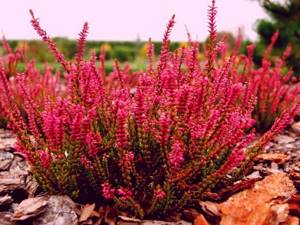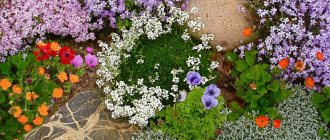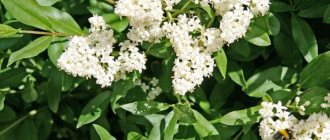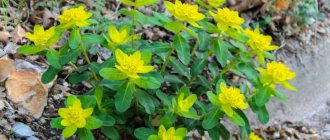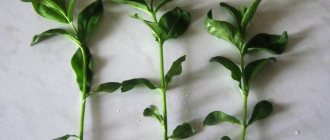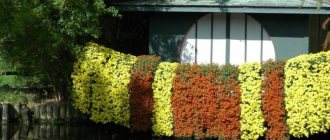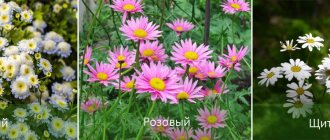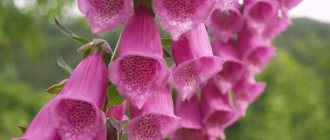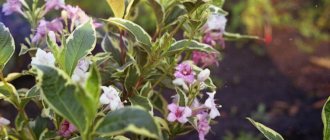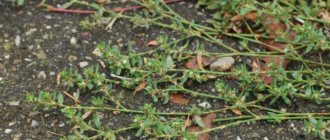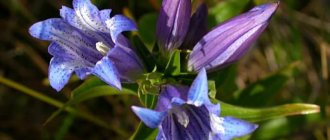Evergreens are a large group of plants that maintain the same appearance all year round. Among them are not only coniferous trees familiar to residents of the middle zone, but also creeping plants, shrubs, and herbs. Many of them are frost-resistant, most are shade-loving. They are great for a garden in a country house or country house due to a number of advantages:
- Aesthetics. Deciduous plants fly away in winter and take on a somewhat shabby and dull appearance. There is no such problem with evergreens - they always look equally attractive.
- Unpretentiousness. Most species need shade, fertilizer and watering, but do not require anything more. Even the cold wind cannot harm them.
- Great variability. Among the species you can find trees and shrubs, grasses and ivy. For any task, a suitable plant and a suitable color will be found.
If you have imagination and funding, you can use evergreen ornamental plants to make your site look festive and beautiful even in winter.
Evergreens in an English garden
Flower garden with evergreens
Use Cases
Evergreen plants for the garden can be used in the design of the site in a variety of ways.
Landings
The simplest option is to plant plants so that they shade different corners of the garden. If you combine different heights and different shades of foliage, even in winter there will be some diversity in the area.
Hedge
If you make it from deciduous plants shedding their leaves, in winter it will lose all meaning and turn into an interweaving of dull black branches, through which you can clearly see what is happening on the site. If you use evergreens for a hedge, even in winter it will retain its impenetrability and chic appearance.
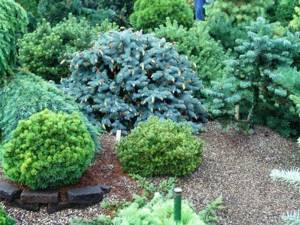
Garden decor with evergreens
Living sculptures
Made from plants that shed their leaves, the sculptures become quite unsightly in winter. Made from evergreens, they will retain their shape and chic even under the snow.
Curbs
Zoning an area is one of the best functions of low-growing shrubs. They can be used to separate plantings from paths, paths from lawns and lawns from the house. In addition to the aesthetic function, they can also perform a protective function: do not allow the wind to pass through, do not allow weeds or grass to grow from the lawn.
Decorating fences, gazebos and any trellises
For this purpose, evergreen climbing plants are best suited, which will allow you to make your house or gazebo look like castles covered with ivy in winter.

Spruce in the garden
Depending on the purpose, you need to choose suitable plants - each of them is good for achieving certain goals.
Types of evergreens
Evergreen plants are numerous and varied. Their household classification is quite simple. Based on the type of foliage, evergreen plants are:
- Conifers are the most familiar to the middle zone and familiar to every inhabitant: pine, spruce, fir.
- Deciduous plants are less common plants that can retain their foliage even in winter. The most famous and popular of them is boxwood.

Evergreen plants are divided differently by shape. Among them are:
- Trees are fairly tall plants with a clearly visible trunk.
- Shrubs are relatively low plants, in which either the trunk cannot be clearly distinguished, or there are several identical trunks.
- Lianas are climbing plants that cling to any support provided.
- Herbs are plants that have a stem instead of a trunk. Among the evergreen varieties, there is even one palm tree that is technically an evergreen.
- Mosses are unusual for gardeners in the middle zone, but are very popular in Japan. With their help, the garden can be completely transformed.
In each sub-clause of the classification there are plants that can be used for the garden. The main thing is to figure out which one is suitable for what.

Evergreen hedge
Evergreens: photos and names, overview of crops suitable for the garden
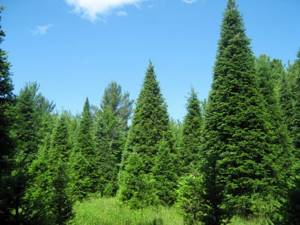
Evergreens can decorate any area, be it a cottage or a garden. These representatives of the flora have gained popularity due to an amazing feature: they do not shed leaves and needles throughout the year. There are many varieties of evergreen trees and shrubs. With their help, you can create unusual compositions; they are used for zoning an area. They are used to create hedges and even sculptures. This article lists the most common evergreen trees and shrubs that can even be placed in the garden.
An evergreen coniferous plant such as spruce will become an indispensable decoration for any site. The most common varieties are spiny and European.
- European spruce reaches a height of 30 meters or more. The width of its spreading crown is 5 meters. The crown has a cone shape. During the first 10 years of life, Norway spruce grows quite slowly, but later its height can increase by 70 cm annually.
- The prickly spruce, if not pruned, reaches a height of 25 meters. The lush crown is lowered low, it almost touches the ground. This plant has sharp needles of blue, green or gray color. This variety of spruce takes root best in well-lit areas. The soil should be loose and moderately moist.

Seedlings are usually planted in the warm season. Norway spruce can grow in slightly shaded areas, but it is best to provide access to sunlight to the tree. For half a month after planting, seedlings must be protected from the scorching sun, otherwise they will burn out. In autumn, plants are covered to prevent them from freezing. Since the roots of spruce trees do not grow in depth, but in width, it is necessary to plant seedlings at a distance of 3 meters from each other. Spruce trees are watered once a decade during dry periods. The crown can be used to form various shapes and hedges, as it lends itself well to pruning.
Spruce
The most popular and familiar tree is found in three versions.
European
The giant spruce, which can grow up to 30 meters in height and spread its branches no less than 5 m. The first decade after planting it grows slowly, then it can gain more than half a meter in height per year. Its decorative varieties are more often used in gardens:
- Akrokona - dark green needles, height only 3 meters;
- Inversa is an unusual spruce, the branches of which bend to the ground, like those of a willow;
- Maxveli is a small two-meter spruce with yellowish needles and a round crown;
- Tompa is a one and a half meter small spruce with a light green crown.

Stone rose in the garden

Porch decor with evergreens
Prickly
Can grow up to 25 meters. The crown is low-hanging with a bluish tint. The spines are long and sharp. It also has decorative subspecies:
- Fastigiata - narrow crown, noble blue tint;
- Guspie is not just a blue tint, but a bright color, height up to 11 meters;
- Fat Albert - bluish tint, height up to 15 meters.
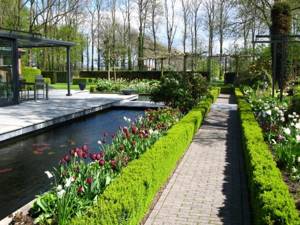
Evergreen bushes
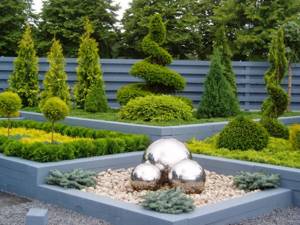
Art Nouveau garden with evergreens
Serbian
The most frost-resistant spruce that can easily tolerate frosts down to 30 degrees. Easy to care for, withstands wind well. It has decorative varieties:
- Alexandra - dense, rounded crown, fast growing;
- Freya - splayed, rigid crown of irregular shape, height up to 3 meters;
- Gnome - spreading rounded crown, bluish tint, about half a meter high;
- Karel is the smallest spruce, barely growing to a meter.
Spruce does not tolerate close proximity to other trees - its roots grow over a large area close to the surface and it makes no sense to plant any other plant closer than at a distance of 3 meters. It also does not like heavy watering, like many other coniferous woody plants. The ideal watering schedule is once every 10 days, little by little.
Loves light and grows well in the sun. It is better to plant seedlings in summer, in dry, loose soil.
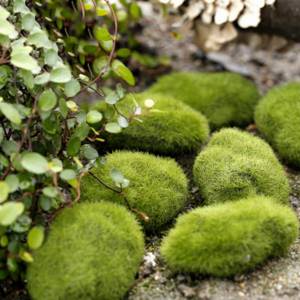
Moss in the garden

Juniper in the garden
Evergreen frost-resistant shrubs for the garden
Most evergreen shrubs are not adapted to harsh winters and require special care during the cold period. But several species can still be grown in temperate climates.
Honeysuckle evergreen
Climbing ornamental shrub. The branches are suitable for creating vertical gardening. They can be used to decorate arches, supports of gazebos, and perfectly camouflage old walls and fences.
The plant is quite unpretentious and grows quickly. Over the course of a season it can weave up to several meters of supports or walls.
During flowering it has a persistent pleasant smell. It blooms until late autumn, after flowering it dresses up with bright red fruits.
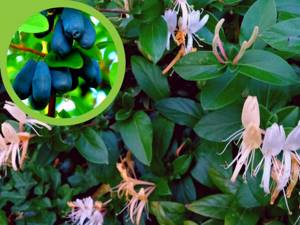
Holly holly
An evergreen plant reaching 15 meters in height. It grows very slowly. It has a dense pyramidal shape, interestingly shaped sheets with sharp edges. Flowers do not amaze with their beauty, which cannot be said about the bright fruits that can stay on the branches all winter.
Prefers shaded places protected from winds. Requires spring pruning to form a bush. It is also necessary to apply mineral fertilizers at the beginning of the season.
The younger the plant, the more care it requires. For the winter, you need to insulate the tree trunk circle, and cover the bush itself using spruce branches or spunbond.
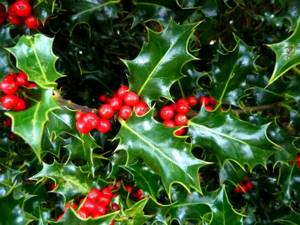
Camellia japonica
This is a beautiful flowering ornamental plant with leathery glossy foliage. It is not winter hardy, but there are artificially bred varieties that can tolerate frost, for example:
- Winter hope
- Winter snowman
- Lady Campbell
- polar ice
- winter star
- Pink icicle
- April dawn
- Korean Fire
- Spring Promise
- Snowfall
- Spring Festival
- Arctic Rose
These varieties can withstand temperatures down to minus 10-17 degrees, but for the winter it is better to cover the plant. They prefer semi-shaded places, on small hills, sheltered from strong winds. The soil must be well prepared before planting - drainage is provided, compost and humus are added.
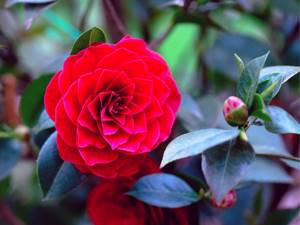
Boxwood evergreen
An incredibly picturesque frost-resistant shrub with dense glossy leaves. Easy to shape. With regular pruning, the crown becomes denser. You can create any fantasy compositions from boxwood. Suitable for creating hedges.
Growing and reproduction:
- Prefers light fertile soil with neutral acidity. Grows well in slightly shaded areas.
- It is quite easily propagated by cuttings. After trimming an adult specimen, sort the cuttings measuring 15-20 cm. Remove the lower leaves and leave them in the root solution for a day.
- Then insert the cuttings into a mixture of sand and fertile soil. Cover with film to maintain high humidity, moisten regularly. Roots will appear in 2 months.
- In spring, when the sun is already getting brighter and the ground is still not warm enough, boxwood needs to be shaded. At this time, if there is insufficient root nutrition, the foliage may burn.
Boxwood grows slowly, adding only a few centimeters per year. Can reach 12 meters. At the same time, it is characterized by longevity.
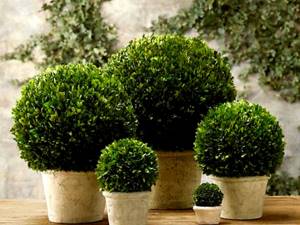
Fir
Fir is a coniferous evergreen plant with grayish, pleasant-colored bark and soft needles. Its roots go deep into the ground, the cones do not fall off, but open directly on the tree. Among the decorative and popular varieties:
- Arizona - reaches 7-8 meters in height, has bright red cones, bluish needles, cream bark;
- balsam - the smallest of the varieties grows to barely half a meter, has smooth brown bark, rich green needles with a white stripe and purple cones;
- monochromatic - grayish bark, bluish-green needles, tips curled upward, height up to 8 meters.
Fir loves bright places and moist, loose soil, so in dry times it requires watering. It does not tolerate severe frosts; in the first year, the roots need a warm layer of spruce branches to cover them.

Pieris in the garden
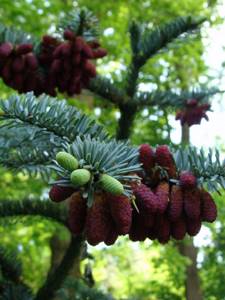
Fir in the garden
Exotic shrubs for the garden
tree peony
It is a deciduous shrub that can reach a height of two meters with flowers up to 20 centimeters in diameter. The tree peony is not very common in central Russia, but it may well become a worthy decoration for your garden; there are many varieties that are resistant to cold weather. Requires shelter for the winter.
Tree peonies prefer well-lit places on a small hill. It is advisable that there are no tall plants or buildings nearby that could block sunlight. The plant prefers loamy soils; organic fertilizers must be added before planting. Since peony grows in one place for several decades, the choice of site and soil composition must be taken responsibly.
Tree peony pruning is carried out in the spring before active growth begins. Dry branches are cut off completely, last year's shoots are shortened, leaving no more than 10 centimeters. The shrub propagates by division and cuttings. The most popular varieties:
- Kiao sisters,
- Sapphire,
- Coral altar,
- Green Jade
Hibiscus (Chinese rose)
Hybrid forms of hibiscus are mostly frost-resistant. They are planted in the ground at the end of May, in a sunny area with fertile, loose soil. Loves regular watering.
Swamp hibiscus overwinters well. Blooms with large red or pink flowers. Each flower of this plant blooms for only 24 hours, then fades and others bloom.
Herbaceous hibiscus is also a cold-resistant variety. It can bloom with red, white or light pink flowers. In winter, the shoots are cut to the ground; in the spring, new ones appear in their place.
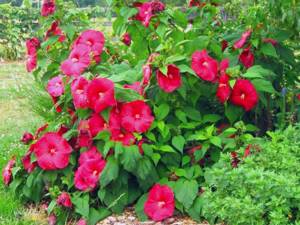
Rhododendron
This is a southern beautiful flowering plant. You can find species adapted to temperate climates. For example: Schlippenbach, Japanese, Katevbinsky.
Rhododendron prefers places with moderate lighting and acidic soil. Does not tolerate drafts and strong winds well. Therefore, it is placed near the southern part of the house or next to good shelter.
Tolerates minor waterlogging well. On hot days, it is necessary to water and spray the foliage more often. For comfortable growth, the plant requires regular nitrogen-containing fertilizing.
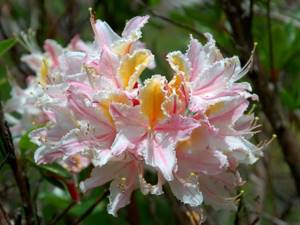
Boxwood
Boxwood is a low-growing ornamental plant that is excellent for landscape work. With its help, you can form a hedge or border, or use it for zoning the garden. Loves sunny or slightly shaded areas, well-loose soil, and frequent, timely watering. It does not tolerate too shaded places or cold - in the fall its roots need to be covered with dry pine needles or sawdust.
Boxwood is a perennial plant that grows quickly and chaotically in height and requires periodic pruning. Can be quite effective with proper care.
At the same time, boxwood, although beautiful, is poisonous. It is best to care for it with gloves.

Ivy in garden decor

Watering evergreens
Boxwood buxus
One of the first places in the ranking of the most popular evergreen shrubs is occupied by a plant called “Buxus”. Slow-growing boxwood is a welcome guest in many suburban areas. It is convenient because it bushes well and tolerates haircuts well. For this reason, it is often used in the formation of hedges. Shiny foliage, a dense dense crown and the ability to grow even in shaded corners of the garden are the main advantages of the low-maintenance boxwood.
The family unites over 30 species. In landscape design, “Buxus sempervirens” or common boxwood is most widespread. The branches of the plant are tightly covered with small round leaves located opposite each other. Due to the hard leathery surface, the foliage has a characteristic glossy shine.
The varieties of evergreen shrubs under the following names are famous for their greatest decorativeness:
- Latifolia is a plant up to 4 meters high, painlessly tolerating crown formation.
- Rotundifolia - has showy foliage with a bluish tint. It is famous for its greatest winter hardiness among boxwoods;
- Handsworthiensis is a compact plant with strong shoots, widely used by craftsmen for artistic carving.
- Suffruticosa is a low-growing variety that easily tolerates heavy shade.
Boxwood is one of the flowering shrubs. But there is no particular value in its buds. Flowering lasts from March to April. The main advantage of inconspicuous flowers is the pleasant aroma spread throughout the area during this period.
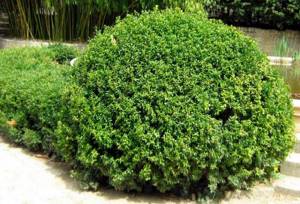
Juniper
Juniper is one of the most popular evergreen plants. It can reach up to 12 meters in height, has a pleasant smell and beautiful cones, which over time turn from green to gray and begin to resemble berries. It has several decorative varieties:
- Montana - very low-growing shrubs that hardly grow to 20 cm;
- Klumnaris are also short, grow up to half a meter and have needles with a noble blue tint;
- Mass - creeping shrubs with bluish-green needles.
Juniper grows for a long time and requires virtually no care - it only needs to be watered during drought and occasionally loosen the soil. Sometimes you can add fertilizer.
One of the exotic advantages of juniper that herbaceous evergreens cannot boast of is its cones. They can be used as a seasoning for meat or fish. They give the finished dish a pleasant fresh aroma.
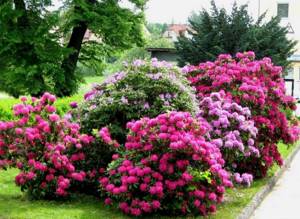
Rhododendrons in the garden
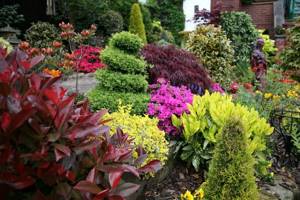
Evergreen garden
Lianas and mosses
They can be combined into a single group because they are less popular than trees and shrubs. However, when used correctly, they can look no less impressive and at the same time much more original.
Ivy is a climbing evergreen deciduous plant. Loves warmth, loose acidic soil, and an abundance of garters that can be braided. Its leaves reach a quarter of a meter in length, their color is greenish, yellowish or grayish. In autumn, flowers appear on the branches - small, green and umbrella-shaped - which by spring become large black berries with a pleasant nutmeg scent. They can be used as a spice.

Boxwood in the garden
Bindweed is an evergreen plant that does not lose its attractiveness in winter. The leaves are silver-gray and blooms all summer, producing pink buds that open into white flowers. Needs supports, can easily braid a fence, hedge, trellis, gazebo posts. During severe frosts, it is better to cover it from the cold.
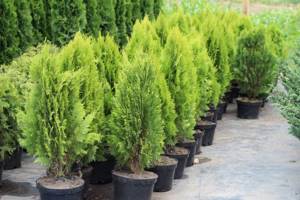
Evergreens
Moss - garden varieties of moss look very impressive and can replace a lawn, as they can easily overwinter under a layer of snow. They grow well in the shade, where the soil is acidic and humid. They do not require any special care and can actually grow on their own.

Japanese garden with evergreens
Evergreens are easier to care for than most others. Periodic watering, a little care before the winter period, interested observation of how things grow and spread - and even in winter the garden will look absolutely magical in summer.
Flowering shrubs
Spirea
These are fast-growing shrubs, frost-resistant and unpretentious.
Spiraea is divided into two types: spring-flowering and summer-flowering. In spring, the branches are completely decorated with tiny white flowers. They bloom once per season.
Summer-flowering varieties have a longer flowering period. The flowers are collected in spherical or spike-shaped inflorescences of pink and yellow shades. Popular summer varieties Bumalda, Goldflame. Spiraea japonica Crispa is distinguished by its picturesque flowers. The compact spherical shape of summer spirea is helped by pruning every spring to the stump.
The combination of spring-flowering and summer-flowering varieties allows you to enjoy beautiful flowering for a long time.
Main characteristics:
- Spiraea is not picky about soil.
- They grow equally well in partial shade and sun.
- The shrub is winter-hardy and does not require shelter.
- Spiraea goes well with hostas and juniper.
- Low-growing varieties are suitable for borders and rockeries.
Hydrangea
Tree hydrangea is a North American shrub that is very resistant to low temperatures. Our summer residents love hydrangea; they often choose varieties with unusual colors of inflorescences - red, blue, lilac. They look impressive and at the same time quite capricious. For beginners in growing this shrub, it is better to choose a tree-like variety with white caps.
Hydrangea paniculata is suitable for harsh regions. This is a winter-hardy variety up to three meters high with a dense crown. Inflorescences are broad pyramidal panicles 20-30 cm long and about 30 cm wide, white and turning red in autumn.
Characteristic features of hydrangeas:
- Moisture-loving shrubs that do well in the shade.
- They prefer soil that is drained and fertile, with a low peat content.
- Can be planted as single bushes or in groups.
- The plant harmonizes perfectly with coniferous ornamental shrubs.
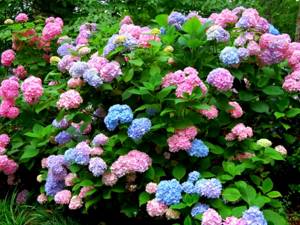
Deytsia
This is a shrub from the hydrangea family, blooms in May-June with beautiful small flowers of white or pink color. The bush has a spreading crown with shoots strewn with flowers, and can reach a height of one and a half meters. The action will become the focus of attention on the lawn, lawn, next to the recreation area.
Characteristics and rules of care:
- Not picky about soil quality, prefers sunny or partial shade, without stagnant moisture. Resistant to drought and pests.
- Branches need to be pruned after flowering. In winter, it is better to press the shoots to the ground, since at temperatures below 20 degrees they can freeze.
- Deutzia is suitable for decorative hedges without clearly defined contours.
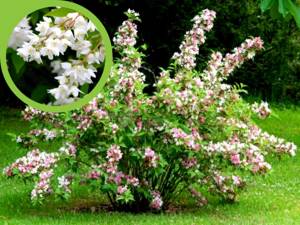
Cinquefoil shrub
Not a very common shrub, but bright and long-flowering. Cinquefoil is easy to care for and resistant to frost. Flowering lasts from early summer until late autumn; the bush can reach one and a half meters in height.
Potentilla Features:
- Prefers sunny or slightly shaded places. Regular pruning is required.
- Cinquefoils do not tolerate dry air.
- They love fertile, moderately moist soils.
- Cinquefoil is used to create borders, hedges, in single plantings and in groups.
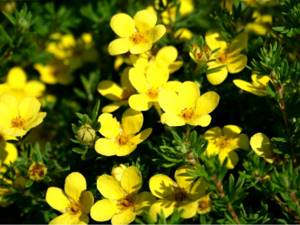
Bladderwort viburnum
A fast-growing, frost-resistant shrub with golden or purple leaves. It can reach 3 meters in height. Decorative at any time of the year - in spring with bright leaves, with corymbose inflorescences, in autumn with red fruits.
Characteristics:
- The shrub is unpretentious, drought-resistant.
- It can grow in partial shade, but feels better in an open area - the leaves will be more saturated in color.
- Tolerates even harsh winters and does not require shelter.
- Tall hedges made from bladderwort are an excellent solution for a bright landscape feature.

Kerria japonica
Deciduous, unpretentious shrub that can bloom from April to October. It has rich greens and bright yellow flowers. The bush can reach two meters in height.
Well-lit places are suitable for growing. In this case, regular and sufficient watering is necessary, since the plant does not tolerate drought.
Kerry is grown singly or in group plantings. Combines with coniferous plants and stands out brightly on the lawn.
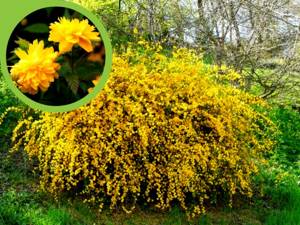
Chubushnik
More often this plant is called garden jasmine. Blooms in early summer with fragrant white flowers. Winter-hardy varieties include: “Chamomile”, “Snow Avalanche”, “Yunnat”, “Arctic”, “Pearl”, “Elbrus”.
- Mock orange needs to be pruned regularly to form an aesthetic crown. First, the branches are pruned after flowering. In spring - old shoots. Only last year's strong branches are left.
- For the first few years after planting, it is better to cover garden jasmine for the winter.
- Moderate watering is needed; before planting the bush, drainage is placed in the hole. The tree trunk circle is mulched.
- Mock orange is well suited for creating high decorative hedges - up to 2 meters. Single plants are also used in garden design, combining them with herbaceous perennials.
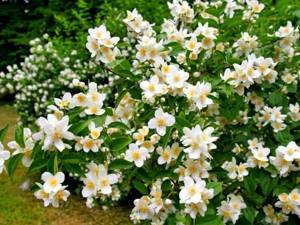
Clematis (clematis)
A climbing perennial plant with a long flowering period. Clematis decorate arches and pergolas. A wide selection of varieties allows you to purchase vines with different types and shades of flowers.
Features of cultivation:
- Grows well in an open sunny place, protected from cold winds.
- Prefers fertile, well-drained soil. Loam mixed with lime is best suited. Clematis does not tolerate stagnant moisture.
- The root system must be protected from overheating by shading and mulching. During the cold period, shoots may freeze above the level of snow cover. Therefore, shelter for the winter will not be superfluous.
- The seedling is planted in a permanent place at the end of April or beginning of May. In one place it grows up to 15 years.
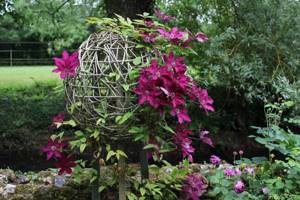
Weigela
A very beautiful shrub during flowering. Requires quite a lot of space for spreading branches. It is necessary to leave a distance of about two meters between the bushes. Flowering occurs in May-June, and can bloom again. Due to its high decorative value, it is suitable for planting in the foreground, at the entrance to the house, next to the recreation area.
- Weigela needs fertile soil. The place is preferably protected from the wind; partial shade or direct sunlight is suitable.
- It should be pruned annually; after flowering, the branches also need to be shortened.
The following varieties are frost-resistant:
- Bristol ruby
- Alba
- Styriaca
- Striatum

Heather
Low herbaceous shrub. In nature it grows on mountain slopes. Therefore, it looks good in large quantities; entire clearings are often formed from it.
Well-lit places are suitable for growing. Prefers acidic soils.
Although heather is a frost-resistant crop, it needs winter shelter. In autumn, faded branches are cut off, the plant is covered with spruce branches, and the ground is mulched with peat.
Heather will diversify your landscape with long-lasting decorative flowering. Suitable for growing on alpine hills, it perfectly complements conifers.
